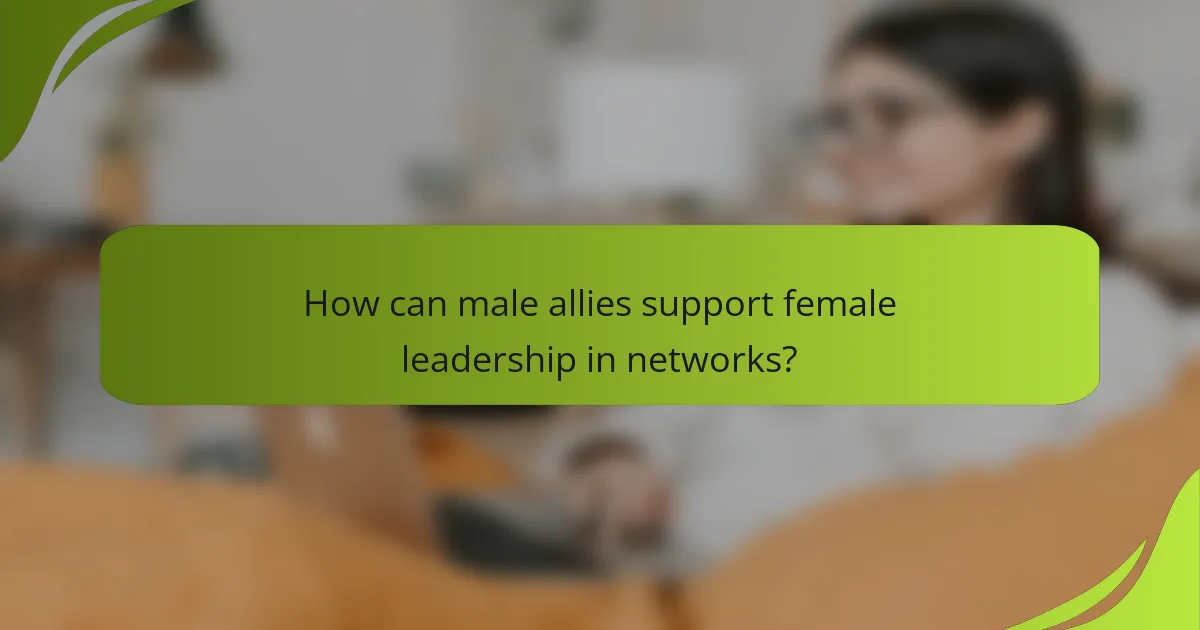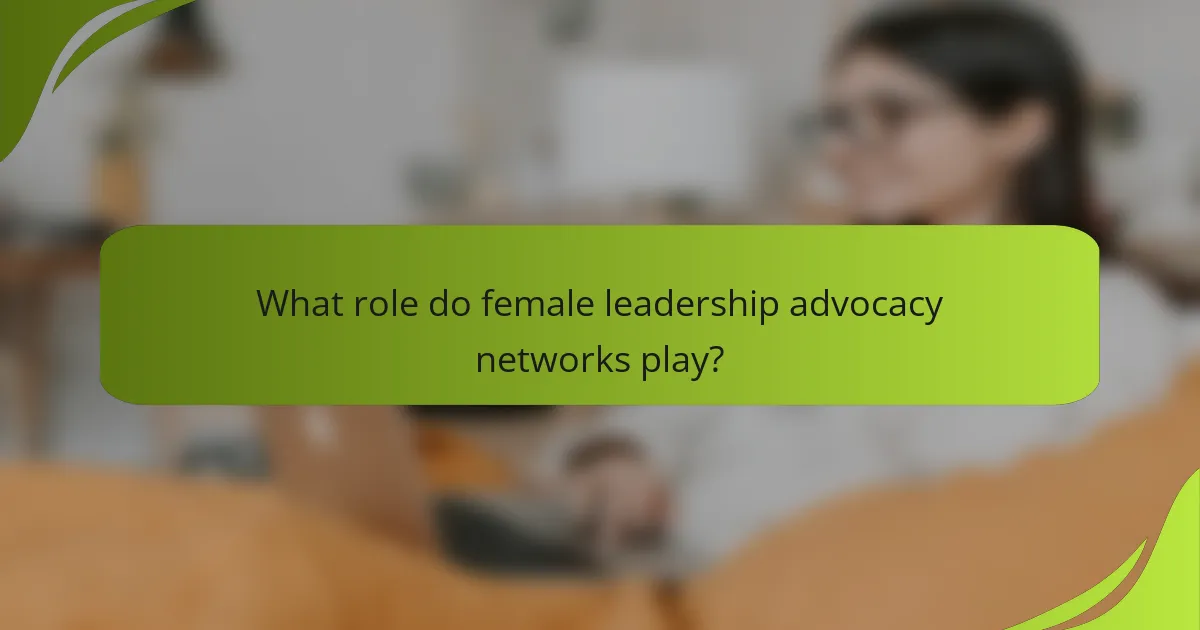Female leadership advocacy networks play a crucial role in empowering women to assume leadership positions by fostering an inclusive environment. Engaging male allies in mentorship and advocacy is essential, as their active participation can enhance collaboration and support for female leaders. By implementing intentional strategies that promote mutual respect and shared leadership, these networks can create a more equitable landscape for all leaders.

How can male allies support female leadership in networks?
Male allies can significantly enhance female leadership in networks by actively participating in mentorship, advocacy, and collaborative efforts. Their support can create a more inclusive environment that empowers women to take on leadership roles.
Mentorship programs
Mentorship programs are essential for fostering female leadership, and male allies can play a pivotal role by mentoring women in their fields. These programs should focus on pairing experienced male leaders with emerging female talent to provide guidance, feedback, and career advice.
To establish effective mentorship, organizations can create structured programs that outline goals, expectations, and regular check-ins. This helps ensure that both mentors and mentees are engaged and benefiting from the relationship.
Advocacy initiatives
Male allies can support female leadership through advocacy initiatives that promote gender equality within organizations. This can involve actively speaking out against gender bias, supporting policies that favor diversity, and encouraging other men to join the cause.
Effective advocacy initiatives often include awareness campaigns, workshops, and discussions that highlight the importance of female representation in leadership roles. Allies should aim to be visible in their support, demonstrating commitment to change.
Networking opportunities
Creating networking opportunities is crucial for women to connect with influential leaders and peers. Male allies can facilitate these connections by inviting female colleagues to industry events, panels, and discussions where they can showcase their skills and build relationships.
Organizations can enhance networking by hosting mixed-gender events that encourage collaboration and open dialogue. This approach helps break down barriers and fosters a supportive community for women in leadership.
Training workshops
Training workshops can equip women with the skills and confidence needed for leadership roles. Male allies can support these initiatives by participating as facilitators or sponsors, ensuring that women have access to valuable resources and training.
Workshops should focus on key areas such as negotiation, public speaking, and leadership strategies. Providing a safe space for women to practice these skills can significantly boost their confidence and readiness for leadership positions.
Collaborative projects
Engaging in collaborative projects allows male allies to work alongside female leaders, fostering mutual respect and understanding. These projects can range from joint research initiatives to community service efforts that highlight the strengths of diverse teams.
To maximize impact, organizations should encourage mixed-gender teams for projects, ensuring that both male and female perspectives are represented. This collaboration not only enhances project outcomes but also builds lasting professional relationships.

What are effective strategies for engaging male allies?
Engaging male allies in female leadership advocacy requires intentional strategies that foster collaboration and mutual respect. Effective approaches include inclusive communication, shared leadership roles, and recognizing contributions to create a supportive environment for all leaders.
Inclusive communication
Inclusive communication involves creating a dialogue that welcomes diverse perspectives and encourages open discussions. This can be achieved by using gender-neutral language and actively seeking input from male allies during meetings and decision-making processes.
To foster inclusive communication, organizations can implement training sessions that focus on unconscious bias and active listening skills. Regular feedback mechanisms can also help ensure that all voices are heard and valued.
Shared leadership roles
Sharing leadership roles between male and female leaders can enhance collaboration and promote gender equity. This approach allows male allies to take active roles in mentoring and supporting female colleagues, thereby creating a more balanced leadership structure.
Organizations can facilitate shared leadership by establishing co-leadership positions or project teams that include both male and female leaders. This not only helps in skill development but also builds trust and camaraderie among team members.
Recognition of contributions
Recognizing the contributions of male allies in female leadership advocacy is crucial for maintaining their engagement. Acknowledgment can take various forms, such as public praise, awards, or highlighting their efforts in company communications.
To effectively recognize contributions, organizations should establish clear criteria for acknowledgment and ensure that recognition is timely and specific. Celebrating successes together reinforces the importance of collaboration and motivates continued support from male allies.

What role do female leadership advocacy networks play?
Female leadership advocacy networks are essential in fostering an inclusive environment where women can thrive in leadership roles. These networks provide resources, support, and connections that empower women while actively engaging male allies in mentorship and advocacy efforts.
Creating supportive environments
Supportive environments are crucial for the success of female leaders. Advocacy networks create spaces where women can share experiences, challenges, and strategies without fear of judgment. This camaraderie fosters resilience and encourages women to pursue leadership positions.
To cultivate such environments, networks often host workshops, seminars, and networking events that emphasize collaboration and mutual support. These gatherings can help build confidence and provide practical tools for navigating workplace dynamics.
Facilitating mentorship connections
Facilitating mentorship connections is a key function of female leadership advocacy networks. By pairing emerging female leaders with experienced mentors, these networks help bridge the gap between aspiration and achievement. Mentorship can take various forms, including one-on-one meetings, group mentoring sessions, or virtual mentorship programs.
Successful mentorship connections often involve setting clear goals and expectations. Both mentors and mentees should communicate openly about their needs and objectives to maximize the benefits of the relationship. Regular check-ins can help maintain accountability and foster growth.
Promoting gender equity
Promoting gender equity is a central mission of female leadership advocacy networks. These organizations work to raise awareness about gender disparities in leadership roles and advocate for policies that support equal opportunities. This includes pushing for equitable hiring practices and promoting women into leadership positions within organizations.
To effectively promote gender equity, networks often collaborate with businesses and institutions to implement training programs that address unconscious bias and foster inclusive leadership. Engaging male allies in these initiatives is vital, as they can play a significant role in advocating for change within their organizations.

What are the benefits of male allyship in mentorship?
Male allyship in mentorship offers significant advantages, including fostering a more inclusive environment and enhancing the development of female leaders. Engaging male mentors can help break down barriers and create opportunities for women to thrive in their careers.
Enhanced diversity
Male allyship contributes to enhanced diversity within organizations by promoting the inclusion of women in leadership roles. When men actively support female colleagues, it encourages a broader range of voices and perspectives in decision-making processes.
Organizations with diverse leadership teams tend to perform better, as they can better understand and serve varied customer bases. This diversity can lead to increased innovation and improved problem-solving capabilities.
Broader perspectives
Engaging male allies in mentorship brings broader perspectives to the table, enriching discussions and decision-making. Male mentors can share insights from their experiences, helping female mentees navigate challenges and seize opportunities in their careers.
By collaborating with male allies, women can gain access to networks and resources that may otherwise be unavailable. This exchange of ideas fosters mutual growth and understanding, ultimately benefiting the entire organization.
Improved organizational culture
Male allyship can significantly improve organizational culture by promoting respect, collaboration, and support among all employees. When men advocate for women, it sets a precedent for inclusivity and encourages others to follow suit.
A positive culture that values allyship can lead to higher employee satisfaction and retention rates. Organizations that prioritize mentorship and support for women are often seen as more attractive to top talent, enhancing their overall competitiveness in the market.

What challenges do male allies face in mentorship?
Male allies in mentorship often encounter several challenges that can hinder their effectiveness. These challenges include fear of backlash, lack of awareness about the needs of female mentees, and misunderstandings regarding their roles in the mentorship dynamic.
Fear of backlash
One significant challenge for male allies is the fear of backlash from peers or superiors. They may worry that their support for female colleagues could be perceived as favoritism or lead to accusations of inappropriate behavior.
This fear can create hesitation in engaging fully in mentorship opportunities. Male allies should consider establishing clear boundaries and maintaining professionalism to mitigate potential backlash.
Lack of awareness
Many male allies may lack awareness of the specific challenges faced by women in the workplace. This can result in a disconnect between their mentorship efforts and the actual needs of their female mentees.
To overcome this, male allies should actively seek to educate themselves about gender dynamics and the unique obstacles women encounter, such as unconscious bias and workplace discrimination.
Misunderstanding of roles
Male allies sometimes misunderstand their roles in mentorship, viewing themselves as saviors rather than partners. This mindset can lead to ineffective mentorship that does not empower female mentees.
It is crucial for male allies to adopt a collaborative approach, recognizing that their role is to support and uplift rather than to dictate or control the mentorship process. Engaging in open dialogue with mentees can clarify expectations and foster a more productive relationship.

How can organizations foster male allyship?
Organizations can foster male allyship by creating inclusive environments that encourage men to actively support and mentor women in leadership roles. This involves implementing strategies that promote awareness, education, and engagement among male employees.
Training programs
Training programs are essential for equipping male allies with the knowledge and skills needed to support female leadership effectively. These programs should focus on topics such as unconscious bias, effective communication, and the importance of diversity in the workplace.
Organizations can implement workshops or seminars that include role-playing scenarios and discussions to help participants understand the challenges faced by women in leadership. For instance, a workshop might involve case studies that highlight successful mentorship relationships between male allies and female leaders.
To maximize impact, training should be ongoing rather than a one-time event. Regular refreshers or advanced sessions can help maintain awareness and reinforce the commitment to allyship, ensuring that male employees remain engaged in supporting their female colleagues.

